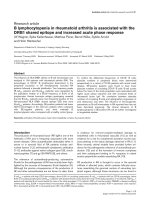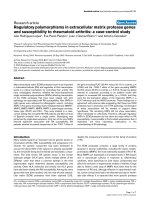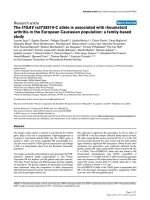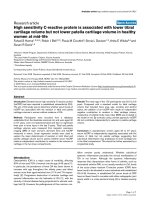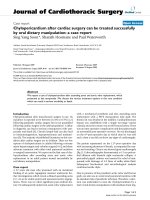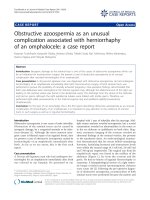Báo cáo y học: "Obstructive azoospermia as an unusual complication associated with herniorrhaphy of an omphalocele: a case repor" ppt
Bạn đang xem bản rút gọn của tài liệu. Xem và tải ngay bản đầy đủ của tài liệu tại đây (533.31 KB, 3 trang )
CAS E REP O R T Open Access
Obstructive azoospermia as an unusual
complication associated with herniorrhaphy
of an omphalocele: a case report
Kazunari Tsuchihashi, Kazutoshi Okubo, Kentaro Ichioka, Takeshi Soda, Koji Yoshimura, Akihiro Kanematsu,
Osamu Ogawa and Hiroyuki Nishiyama
*
Abstract
Introduction: Iatrogenic damage to the seminal tract is one of the causes of obstructive azoospermia, which can
be an indication for reconstruction surgery. We present a case of obstructive azoospermia as an unusual
complication after neonatal herniorrhaphy of an omphalocele.
Case presentation: A 30-year-old Japanese man was diagnosed with obstructive azoospermia. He had undergone
herniorrhaphy of an omphalocele immediately after birth. Reconstruction surgery of both seminal tracts was
performed to pursue the possibility of naturally achieved pregnancy. Intra-operative findings demonstrated that
both vasa deferentia were interrupted at the internal inguinal rings, although the abdominal end of the right vas
leading to the seminal vesicle was found in the abdominal cavity. The discharge from the stump of the testicular
end had no sperm, although the right epididymal tubules were dilated with motile sperm. Therefore, we
performed right-sided vasovasostomy in the internal inguinal ring and ipsilateral epididymovasostomy
simultaneously.
Conclusion: To the best of our knowledge, this is the first report describing obstructive azoospermia as an unusual
complication of herniorrhaphy of an omphalocele. It is important to pay attention to the existence of seminal
tracts in such surgery as well as in inguinal herniorrhaphy.
Introduction
Obstructive azoospermia is one cause of male infertility.
Obstruction of the seminal tracts can be caused by
iatrogenic damage, by a congenital anomaly or by inf ec-
tious diseases [1]. Although the most co mmon iatro-
genic cause is bilateral repair of an inguinal hernia, here
we present a case of obstructive azoospermia caus ed by
herniorrhaphy of an omphalocele immedia tely after
birth. As far as we are aware, this is the first such
report.
Case presentation
A 30-year-old Japanese man who had undergone her-
niorrhaphy for an omphalocele immediately after birth
was referred to our hospital. H e presented to our
hospital with 1 year of infertility after his marriage. Mul-
tipl e semen analyses revealed azoospermia, but a scrotal
examination revealed no abnormali ties in the testes or
in the vas deferens or epididymis on both sides. Mag-
netic resonance imaging of the scrotum revealed no
abnormal findings in the seminal vesicles, t he prostate
or the ejaculatory ducts. An endocrinological examina-
tion demonstrated that his serum follicle-stimulating
hormone, luteinizing hormone and testosterone levels
were within the normal range (4.1 mIU/ml, 3.6 mIU/ml
and 7.48 ng/ml, respectively). The surgical scar from his
omphalocele repair was found in the midline of the
abdomen (Figure 1), far from the scrotum and the
groin. He had no history of inguinal herniorrhaphy or
vasectomy. A histopathological section of a right testicu-
lar biopsy revealed normal spermatogenesis (Johnsen
score count 10) [2]. Following the pre-operative diagno-
sis of obstructive azoospermia, reconstructions of both
seminal tracts were performed because the patient and
* Correspondence:
Department of Urology, Graduate School of Medicine, Kyoto University, 54
Shogoin Kawahara-cho, Sakyo-ku, Kyoto 606-8507, Japan
Tsuchihashi et al. Journal of Medical Case Reports 2011, 5:234
/>JOURNAL OF MEDICAL
CASE REPORTS
© 2011 Tsuchihashi et al; licensee BioMed Central Ltd. This is an Open Access article distributed under the terms of the Creative
Commons Attribution License ( /licenses/by/2.0), which permits unrestricted use, distribution, and
reproduction in any medium, pr ovided the original work is properly cited.
hiswifestronglywantedtopursuethepossibilityofa
natural pregnancy. Intra-operativ e vasography demon-
strated that both vasa deferentia were interrupted at the
internal inguinal rings (Figure 2). The abdominal end of
the left vas could not be identified, but the abdominal
end of the right spermatic duct was found in the abdom-
inal cavity. The discharge from the stump of the testicu-
lar end of the vas had no sperm, whereas the right
epididymal tubules were dilated with motile spermatozoa.
Therefore, we performed a right-sided vasovasostomy
and ipsilateral epididymovasostomy simultaneously.
Disappointingly, post-operative semen analyses demon-
strated azoospermia. Finally, he fathered a child by intra-
cytoplasmic sperm injection (ICSI) using testicular sperm
that had been retrieved and cryopreserved at the time of
the testicular biopsy.
Discussion
Azoospermia is one of the causes of male infertility.
Azoospermic patients whose testes show normal sper-
matogenesis on the basis of histopathology are diag-
nosed as having obstructive azoospermia. Cases of
obstructive azoospermia are classi fied into t wo groups
according to the obstruction sites. One is an obstruction
in the vas deferens, and the other is one in the epididy-
mis. The causes of epididymal obstruction include infec-
tious diseases and congenital anomalies [1], and the
causes of vasal obstruction include iatrogenic injury or
congenital anomalies. The best-known causes of
iatrogenic injury are vasectomy and bilateral inguinal
herniorraphy [3]. There have been several reports of
other causes of iatrogenic injury, including hydrocelect-
omy [4], appendectomy [3], spermatocelectomy [3] and
renal transplantation [3]. However, to our knowledge,
there has been no previous re port in the literature on
obstructive azoospermia after herniorrhaphy of an
omphalocele. This is the first report showing that such
surgery immediately after birth can cause azoospermia
when the patient matures.
Omphalocele is a disease of neonates involving the
herniation of intra-abdominal organs because of an
abdominal wall defect, and emergency operations are
gen erally required in most cases. The reported escaping
organs include the small intestine, liver, bladder and
ovary [5]. There is no report regarding the escape of
seminal tracts; however, we think there is a possibility
that the vas deferens can escape from the abdominal
cavity when the defect in the abdominal wall is exten-
sive. Our patient presented with azoospermia, but he
had normal sperm atogenesis and obstruction of both
vasa deferentia at the internal inguinal rings. These find-
ings are similar to those seen in cases of obstructiv e
azoospermia after repair of bilateral inguinal hernias. It
is important to pay attention to the seminal tracts dur-
ing herniorrhaphy of an omphalocele, as well as in ingu-
inal herniorrhaphy.
The v asa de ferentia are very thin in neonates [6]. This
might be why iatrogenic damage is often identified after
pediatric surgery [3]. The second reason might be the
recent advances in assisted reproductive te chnologies
(ART). Because of the growth in the number of centers
offering ART and the ability to perform in vitro fertiliza-
tion (IVF) in cases of severe male factor infertility, there
has been a trend toward pursuing IVF, including
Figure 1 Surgical scar from the omphalocele repair of the
abdomen. Note that the scar is far from the scrotum and the groin.
Figure 2 Bilateral vasography in which contrast medium was
injected from into the vas deferens on the epididymal side.
Both vasa deferentia were interrupted at the internal inguinal rings
(arrows).
Tsuchihashi et al. Journal of Medical Case Reports 2011, 5:234
/>Page 2 of 3
testicular sperm extraction ICSI, as a f irst-line therapy
for obstructive azoospermia [7]. This trend might lead
to the clinician’s missing rare co mplications after hernia
surgery. Thus, the need for long-term follow-up of all
patients who underwent pediatric hernia surgery is
emphasized.
Conclusion
The case of our patient indicates that herniorrhaphy of
an omphalocele can be an iatrogenic cause of obstruc-
tive azoospermia. This is the first report describing
obstructive azoospermia as an unusual complication of
this surgery. It is important to pay attention to the semi-
nal tracts in herniorrhaphy of an omphalocele, as well as
in inguinal herniorrhaphy.
Consent
Written informed consent was obtained from the patient
for publication of this case report and any accompany-
ing images. A copy of the written consent is available
for review by the Editor-in-Chief of this journal.
Authors’ contributions
KT, TS and HN performed the surgical procedure and reported the case. KY
and AK interpreted and analyzed the findings. OO participated in the
diagnostic and therapeutic decisions. KO and KI made major contributions
to the writing of the manuscript. All authors read and approved the final
manuscript.
Competing interests
The authors declare that they have no competing interests.
Received: 30 January 2010 Accepted: 25 June 2011
Published: 25 June 2011
References
1. Ichioka K, Kohei N, Okubo K, Nishiyama H, Terai A: Obstructive
azoospermia associated with chronic sinopulmonary infection and situs
inversus totalis. Urology 2006, 68(204):e5-e7.
2. Johnsen SG: Testicular biopsy score count: a method for registration of
spermatogenesis in human testes: normal values and results in 335
hypogonadal males. Hormones 1970, 1:2-25.
3. Sheynkin YR, Hendin BN, Schlegel PN, Goldstein M: Microsurgical repair of
iatrogenic injury to the vas deferens. J Urol 1998, 159:139-141.
4. Hopps CV, Goldstein M: Microsurgical reconstruction of iatrogenic injuries
to the epididymis from hydrocelectomy. J Urol 2006, 176:2077-2079.
5. Pringle KC: Abdominal wall defects and obstructive uropathies: aetiology
and management. Fetal Ther 1988, 3:67-83.
6. Pryor JL, Mills SE, Howards SS: Injury to the pre-pubertal vas deferens. I.
Histological analysis of pre-pubertal human vas. J Urol 1991, 146:473-476.
7. Sigman M: Male infertility. In Campbell-Walsh Urology. Volume 1 9 edition.
Edited by: Walsh PC. Philadelphia: Saunders Elsevier; 2007:609-653.
doi:10.1186/1752-1947-5-234
Cite this article as: Tsuchihashi et al.: Obstructive azoospermia as an
unusual complication associated with herniorrhaphy of an omphalocele:
a case report. Journal of Medical Case Reports 2011 5:234.
Submit your next manuscript to BioMed Central
and take full advantage of:
• Convenient online submission
• Thorough peer review
• No space constraints or color figure charges
• Immediate publication on acceptance
• Inclusion in PubMed, CAS, Scopus and Google Scholar
• Research which is freely available for redistribution
Submit your manuscript at
www.biomedcentral.com/submit
Tsuchihashi et al. Journal of Medical Case Reports 2011, 5:234
/>Page 3 of 3
